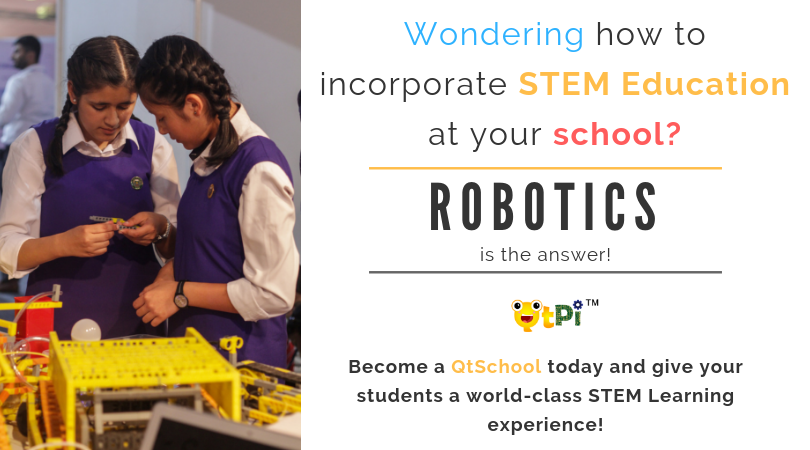One lab, unlimited ideas and projects to build 21st Century Skills through a fun learning way.
QtSchool are in 50+ Schools, with 75+ STEAM trainers, for 20K+ students since 2016. QtSchool is an initiative of QtPi Robotics which provides affordable and customizable robotics curriculum to schools for K-12 and above. With being the best in implementing STEAM education, it also focuses on a unique learning paradigm DESI which expands as Design, Electronics, Software and Integration where children are introduced to the process of developing solution-driven prototypes to mundane problems around them.
- QtSchool lab values empathy and celebrates creativity by preparing children for 21st century skills driven by their own learning ways.
- QtSchool lab is learning by an original and personal process of discovery. Discovery is not just limited to know facts but the thrill of discovering the undiscovered. When this happens, success knocks good grades, financial reward, dreams build and propels passion into a creative career.
- QtSchool lab will provide a sense of ownership in the learning process.
- QtSchool lab uses curricular projects to teach concepts and skills in different subjects, with a focus on critical thinking and problem-solving. It is project based learning: learning by doing.
Can you name some of schools that has QtSchool Labs?
We have over 50+ labs, to name few:
- BRS Global School, Bengaluru
- Guru Nanak Dev School, Bidar
- Jubliee Hills Public School, Hyderabad
- Bishop Cotton Girls' School, Bengaluru
- Ryan International School, Noida
How experiential learning will be taught?
Students role-play by being architects and engineers. They apply the STEAM knowledge they are learning in the classroom. Projects like construction of walls or bridges or skyscrapers encourage students to engage in a variety of subjects areas and develop their own design. Math and Science become relevant to their lives through this tactile experience with materials and imagination.
How concepts are introduced to students?
Let’s say a second-grader was building a Remote-Control car and assumes the controller is the driver of the car. We begin the lesson by covering forces. We will introduce different kinds of energy – kinetic and potential.
What process will be followed in the classroom?
Students will be asked to define the problem statement for the given exercise. This will begin with questioning and discussion. For example – why do we need a car? On understanding the greater need of mobility, time saver and so on. Next set of questions are discussed. For example, what are the different shapes and colours? Such several questions and discussions introduce geometrical shapes.
A good problem is defined by gathering information which in turn leads to designing a prototype until the finished product is ready for presentation and display. The design process is lively and nebulous.
How is the design process taught?
The design process has the following steps –
Identify the challenge: What are you asked to do?
Brainstorm: How are you going to solve the problem?
Design: How will you sketch out or plan your ideas?
Build: How will your model look?
Test and Evaluate: Does your design work?
Rebuild: Do certain changes make your design work effectively?
Share the solution: How will you present the project to your peers?
How is it transdisciplinarty?
Let’s look into an example. Introduction of ‘Time Scale’ with digital and analog. The latter has numbers and moving hands which enables children to start thinking about the concepts of fractions while learning how to tell time. This is also a great opportunity to introduce phrases like ‘half-past’ or ‘quarter-to’. Such learning takes while they build some technical projects like basketball counters where time and counting is required.
Why should kids learn robotics?
Robotics is the best way to learn STEAM and kids learn to appreciate need for multidisciplinary skills needed to build futuristic products. Some of the benefits of QtSchool labs: introduction to real world problems, motor skills, communication skills, and co-creation.
What age kids are part of QtSchool labs?
We introduce STEAM education through Robotics to kids from Grade 1 onwards.
Can you share school principals experience of QtSchool lab?
We would be very happy to connect with them. Some of Principal's experience of having QtSchool lab
Can you share skills children have earned because of QtSchool labs?
"Seeing is believing" : Kids at QtSchool labs apart from learning through DESI model, they have hone on communication through project presentation, collaboration by building projects in groups, critical thinking and creativity by coming up with ideas and asking questions. We also encourage activities like anchoring for QtNews, story telling, drawing, & static models to unleash the creative front.
What parents think about kids learning in QtSchool labs?
We have happy customers and we take feedbacks seriously to improve our process through events like PTM, Science Exhibition, Robotics Exhibition, intra and inter school competitions.
How do I know more about QtSchool labs?
Please check https://qtpi.in/ & connect us (+91) 7022645361 (+91) 7022645961 info@qtpi.in
